Exchanging Databases with Dissimilar Systems Using CCSDS XTCE - PowerPoint PPT Presentation
1 / 21
Title:
Exchanging Databases with Dissimilar Systems Using CCSDS XTCE
Description:
Object Management Group (OMG) standard originally developed ... XTCE Splinter Group. JAXA. T Yamada. NASA/GSFC. DC Lokerson, F Johnson, JK Marquart, JS Gal-Edd, ... – PowerPoint PPT presentation
Number of Views:70
Avg rating:3.0/5.0
Title: Exchanging Databases with Dissimilar Systems Using CCSDS XTCE
1
Exchanging Databases with Dissimilar Systems
Using CCSDS XTCE
- CCSDS Spacecraft Monitoring Control WG
- And
- OMG Space Domain Task Force
- Presented by Mario Merri, ESA
2
Outline
- Where does XTCE come from?
- Its goals and benefits
- How does it work?
- Usage so far
- Conclusions
3
XTCE History
- Object Management Group (OMG) standard originally
developed by - European Space Agency
- US Air force/Mission Operations (Lockheed Martin)
- Boeing Communications Satellites
- NASA JPL
- Being adopted by CCSDS via Agency Review under
responsibility of SMC WG
4
CCSDS SMC and XTCE
- ESA
- M Merri (chairman),
- M Schmidt, A Ercolani,
- J Muller, I Dankiewicz,
- S Cooper
- BNSC
- R Thompson (deputy chairman), B Harnett
- CNES
- B Béhal, E Poupart,
- R Soumagne
- CSA
- P Melanson
- DLR
- H Hofmann
- INPE
- PG Milani, AM Ambrosio
- JAXA
- T Yamada
- NASA/GSFC
- DC Lokerson, F Johnson,
- JK Marquart, JS Gal-Edd,
- C Fatig, R Jones , K Rice
- NASA/JPL
- A Oyake, P Shames, J Moholt
- ASI
- C Labonia
- OMG
- G Simon (Lockheed Martin),
- B Kizzort (Harris Corp.)
XTCE Splinter Group
5
XTCE Goal
- XML-based non-proprietary standard format for
exchanging TM/TC databases that will reduce - human errors,
- ambiguities, confusion, and
- lost time in difficult, sometimes lousy (painful)
conversions between dissimilar systems
6
Application field
- Exchange between
- working teams
- missions
- systems
- agencies
- Reuse database
- Reduce costs
Planning Scheduling
XTCE Format
Command Management
Instrument Manufacturers
Real time
Spacecraft Manufacturers
Simulators
Trending
Analysis
7
XTCE Benefits
- Better interoperation between space agencies and
contractors (or any other actor) - Lets different philosophies collaborate in one
data model - Separates pure telemetry and telecommand data
from dedicated/proprietary processing data - Extensible for data items not currently defined
8
XTCE in a nutshell (1/8)
- An XML Schema language describing data for
- Telemetry definitions
- Data transmission and packaging
- TM/TC parameter properties
- Telecommand definitions
- Non TMTC data is not considered part of XTCE
(dedicated software instructions, SW
configuration variables, page definitions,
real-time scripts, etc.) - TM and TC definitions are 80 similar between
space systems
9
XTCE in a nutshell (2/8)
- XTCE describes a SpaceSystem - command
telemetry descriptions, in a hierarchical format - The granularity of a space systems description
is left to the user, e.g. SpaceSystem may
contain SpaceSystem(s) - The hierarchy allows integration of multiple
databases into one overall database - ex multi-satellite missions, multi-instrument
satellite
10
XTCE in a nutshell (2/8)
Space System
Spacecraft level
Space System
Space System
One satellite DB
Instrument level
Space System
Space System
Device level
11
XTCE in a nutshell (2/8)
Space System
Constellation level
Space System
Space System
Multi-satellite DB
Satellite level
Space System
Space System
Instrument level
12
XTCE in a nutshell (3/8)
- A space system in XTCE is able to describe
- Telemetry parameters, their packaging and
dedicated processing - Telecommand parameters, commands, its packaging
and dedicated processing - Streams (up and down, with coding information)
- Maintain minimal configuration information
- Conversion information
- Limits and pre/post command checks
13
XTCE in a nutshell (4/8)
Space System
- Header for configuration data
- Default for generic settings
- Telemetry for core data
- Telecommand for core data
- Services for frames identification
Header
Defaults
Telemetry
Telecommand
Services
14
XTCE in a nutshell (5/8)
- Telemetry data is distributed in several
elements - Parameter types
- Parameters (instances of parameter types)
- Containers (aka packets)
- Messages
- Streams
- Algorithms
15
XTCE in a nutshell (6/8)
- Logical sequence of definitions
- Parameter types (alarms, calibrations)
- Parameter instances
- Containers (Packets)
- Streams, messages and algorithms
- Example CCSDS TM frames, packets and XTCE
containers
16
XTCE in a nutshell (7/8)
- Parameters are put in sequence to form packets
(containers) - Packets are put together to form frames
- Streams are defined on top of generic frames
Frame primary header
Frame secondary header
Frame data field
Op.ctrl
Err.ctrl
Frame
Packet
Packet header
Packet data field
Ver
Type
P.hdr f
APID
Gr. f
SSC
P.h.len
Packet header
17
XTCE in a nutshell (8/8)
- Telecommand data is distributed in several
elements - Parameter types
- Parameters
- Containers
- Messages
- Streams
- Algorithms
18
XTCE Applications so far
- James Webb Space Telescope XML Schema have been
converted - Future work includes exchanging database with
other archive systems and control center
real-time systems - SCOS-2000 ASCII files have been converted
- Hardware vendors deliver the database information
in XTCE format to the spacecraft integrator on
some US programs
19
CCSDS Documentation
- Draft CCSDS Green book release along with XTCE1.1
for internal CCSDS review - CCSDS Magenta book (detailed user guide) is being
written - CCSDS Red Book released
20
Conclusions
- XML self-describing nature reduces learning curve
and errors - XML is easy to work with, due to the amount of
libraries, tools, and broad industry acceptance - XTCE powerful concepts are ideal for exchanging
legacy, current and future TM TC databases to
planning systems, engineering analysis tools, and
real-time command and control systems - Easily translated between the project XML
database format and XTCE, no longer just a
concept but being used internationally - XTCE covers about 80 of the TM/TC definitions
reducing the errors between dissimilar systems
21
Questions and Answers
?






























